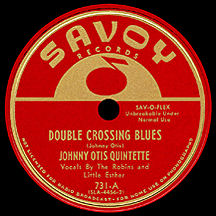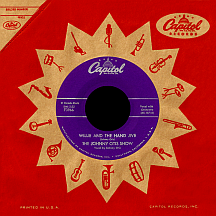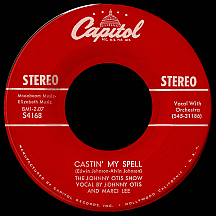JOHNNY OTIS
A percussionist whose talent extended beyond his considerable musicianship, Johnny Otis made his mark as a bandleader, singer, songwriter, producer and arranger, but also as a savvy businessman and entrepreneur with exceptional street smarts. Born Ioannis Veliotes (John for short, Otis an abbreviation of his surname) in Vallejo, California, near San Francisco, he was surely the most soulful Greek dude ever counted among the ranks of 20th century music industry figures. You had to dig his mid-century contributions to jazz, rock and especially rhythm and blues; his white skin was often overlooked, not so unusual considering his dress and mannerisms made him appear as one of African-American heritage; it was an essence that just emanated from his pores!
Johnny got into the "swing" of things in 1940, at the age of 18, drumming for the Oakland-based band led by pianist "Count" Otis Matthews. Other outfits he played for in the early 1940s included Willard Marsh's Collegians (like Johnny, Willard was still a teenager at the time) and the big band of Omaha, Nebraska-based trumpeter Lloyd Hunter. After a stint with Harlan Leonard and his Rockets, performing at the Club Alabam on Central Avenue in Los Angeles, he started his own band at the suggestion of the club's owner, Curtis Mosby, who needed a permanent house band. The joint was jumpin' in the mid-'40s, a regular stomping ground for the likes of T-Bone Walker, Wynonie Harris and Marion Abernathy (who recorded as The Blues Woman). Otis based his sound on the stylings of the Count Basie orchestra and the exposure at the Alabam led to an opportunity to make a record.
He got his chance with the L.A.-based Excelsior Records owned by brothers Leon and Otis Rene (who also ran sister label Exclusive). Johnny's version of "Harlem Nocturne," composed several years earlier by Earle Hagen and Dick Rogers, featured a smooth, smoky alto sax solo by Rene Block; a highlight of their set at the Alabam, it sold respectably well and kicked off a series of recordings for Excelsior. Harris, Charles Brown and Basie vocalist Jimmy Rushing all waxed discs with the band, which featured pianist Bill Doggett, a future R&B star and bandleader in his own right. Otis backed Joe Swift on the singer-composer's late '48 R&B best seller "That's Your Last Boogie," the first national hit to give label credit to the Johnny Otis Orchestra.
Johnny's career was on a roll by '48, the year he went into business with Bardu Ali and Johnny Miller, opening the Barrelhouse Club in L.A.'s Watts district. His band, pared to a smaller combo in keeping with a gradual trend deemphasizing the "big band" establishment, featured Pete Lewis, a guitarist who became an important part of the live shows and recordings while Otis took up vibraphone and piano in addition to drums; the Excelsior release "Midnight in the Barrel House," with Lewis's scorching axe work, became a theme song of sorts for the nightclub. In addition to the music, many black comedians were featured at the Barrelhouse. The club held amateur competitions on Thursday nights during the late '40s and several of the better singers wound up being hired by the club. Local singer Mel Walker (real name Melvin Lightsey) and vocal group The Robins were among those on the verge of becoming nationwide stars, at least with black listeners.
Saxophonist Big Jay McNeely was hired to play at the Barrelhouse in 1949 and both Johnny and Jay signed separate contracts early that year with Savoy Records. McNeely wasted no time, soaring to the number one position on the rhythm and blues charts in February with "Deacon's Hop." It took Otis another year, but in 1950 all the stars aligned. Esther Phillips (born Esther Mae Jones), a petite 13-year-old from Galveston, Texas, with vocal range and phrasing abilities well beyond her age, won a talent contest at the Largo Theater, located near the Barrelhouse. Otis happened to be at the club, checking out the competition, the night she wowed the crowd. He convinced her to forget about the Largo and sing at his joint, suggesting she use the stage name Little Esther.
Ty Terrell, Billy Richard and Roy Richard had worked with Otis as members of The Four Bluebirds; with the addition of bass and baritone singer Bobby Nunn, they became the Robins. "Double Crossing Blues," a slow rhythm number credited to The Johnny Otis Quintette, featured a relationship standoff between Esther and her four vocal counterparts (Nunn: 'What makes your big fat head so hard?'...Esther: 'You should be out in the forest, fightin' a big ole grizzly bear!') and was released at the beginning of 1950, enjoying an exceptional run (over two months at number one) on the R&B charts.
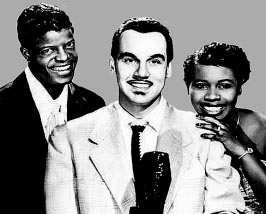
The Robins, with backing from Otis's band, had a hit of their own at the same time, "If It's So Baby." "Mistrustin' Blues," covered a similar theme, paired Esther with Mel Walker and knocked the previous single off the R&B chart summit. From this point, most recordings were released as The Johnny Otis Orchestra and featured various combinations of his featured vocalists with frequent reteamings of Little Esther and Walker as well as solo releases by each. Easily the hottest black act of 1950, the white Johnny Otis was virtually invisible to mainstream pop music fans of the day while his records consistently ranked high on the rhythm and blues charts. "Cupid's Boogie" (with Little Esther), "Dreamin' Blues" (with Mel Walker) and "Deceivin' Blues" (again combining the two) were among the biggest hits of the year.
"Wedding Boogie" had developed as a comedy skit, Esther playing the bride ('I want a he-man to marry me!'), Mel the groom and Lee Graves the preacher ('Do you take this woman to be your wife...to fuss and fight for the rest of your life?'). A favorite of Barrelhouse patrons, it was a hit in the fall of '50. Little Esther left Otis several months later to record for Federal, but it wasn't the last time they would work together. Otis landed more R&B hits in 1951 with Mel Walker, including "Rockin' Blues" and "Gee Baby." "Mambo Boogie" employed some of the hot Cuban rhythms popularized by Perez Prado and others during the era; the instrumental hit (showing off Johnnny's skills on the vibes as many of the Savoy recordings did) broke up his usual pattern of vocal releases. The summer party hit "All Nite Long" was the first to feature a lead vocal by Otis, who tackled his own lyrics without hint of restraint ('...we got a tub full-a whiskey and a barrel-a gin...nobody gonna put you out, if you feel like you wanna shout...ALL NITE LONG!'). He had displayed yet another unforeseen skill; it wouldn't be his last hit as featured vocalist.
Momentum slowed over the course of the year and Otis left Savoy, perhaps prematurely, to record for Mercury. The Robins left as well, making several moves (to RCA Victor, Crown and other labels) before hooking up with Jerry Leiber and Mike Stoller at Spark Records. Bobby Nunn was the only one still with the group in 1955 when they signed with Atlantic Records and soon after started a long, successful run (with guidance from the brilliant Leiber and Stoller) as The Coasters. Otis managed only one hit single during his time at Mercury ("Call Operator 210," a cover of Floyd Dixon's more popular original, featured a vocal by Mel Walker and was one of the few releases not written or cowritten by Otis). He sometimes worked undercover to avoid contract issues with his label and provided backup for Little Esther and Mel Walker, as The J. and O. Orchestra, on their early '52 Federal Records hit "Ring-A-Ding-Doo."
Johnny's eye for talent brought some of the best '50s R&B singers into prominence. Willie Mae "Big Mama" Thornton toured with his band in 1952, leading to her recordings for Peacock and incredible number one R&B hit, "Hound Dog," in the spring of '53. Cowritten by Leiber, Stoller and Otis, the session featured longtime Otis sideman Pete Lewis on guitar. This time around, band credit on the label went to the fictional Kansas City Bill and Orchestra. Later, Otis made similar contributions to Etta James' debut disc, "The Wallflower," a chart-topper in 1955 and start of a long career roller coaster ride for "Miss Peaches."
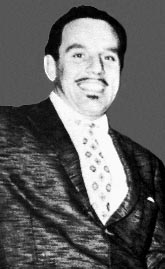
In 1955, Johnny started his own L.A.-based label, Dig, releasing records by mostly-local artists including himself (instrumental "The Midnite Creeper" was a standout release on the label). Despite a number of compelling efforts, there was no breakthrough, and he gave it up after two years to focus on his new ensemble, which he called The Johnny Otis Show (also the name of a popular local TV show he hosted). Signing with Hollywood's Capitol Records, he scored a major hit right off the bat...in England, of all places! "Ma (He's Makin' Eyes at Me)," featuring vocals by another of his discoveries, Marie Adams (backed by The Three Tons of Joy), hit number one in the U.K. in January 1958 and was followed by another hit, "Bye Bye Baby," also featuring a lead vocal by Adams. She became one of the year's biggest stars in the British Isles while remaining virtually unknown in the States.
Back on home turf, the J.O. Show had a delayed reaction, finally catching on in the summer of '58 with a song about '...a cat named Way Out Willie' and a crazy dance the fictional hepster had mastered. "Willie and the Hand Jive," with Johnny's lead vocal, was a smash, reaching the top ten on the pop charts (his only record to do so) in August and becoming his one lasting contribution to rock and roll. "Crazy Country Hop" was next, then "Castin' My Spell," a delightful voodoo-just-for-fun song featuring another of Johnny's female discoveries, Marci Lee.
As hit records became scarce-to-nonexistent in the '60s, his songwriting efforts paid off with a major hit for The Pips (and lead singer Gladys Knight), "Every Beat of My Heart," previously recorded by Hank Ballard's group The Royals nearly a decade earlier. Otis worked with Johnny "Guitar" Watson at King Records in the early '60s but misfired with his own 1961 single, "Hand Jive One More Time," an attempt to further benefit from Way Out Willie's clever dance moves; successive King singles failed to connect. In 1969 he reached the R&B charts for the last time, again as the Johnny Otis Show, with "Country Girl," a bluesy soul shot featuring singer/fast-talker Delmar Evans. His son John Jr. began a career in music at about that time as Shuggie Otis, notching a minor hit in 1975 with "Inspiration Information" and a major one in '77 as the composer of "Strawberry Letter 23," recorded by The Brothers Johnson.
In later years, Johnny Otis found numerous ways to stay involved in music and the arts. He hosted his own radio show in Los Angeles, was a regular columnist for the Sentinel, a newspaper serving the area's black community, dabbled in politics, and served as pastor through much of the '60s for the Landmark Community Church in Los Angeles. His 1971 album for Kent Records, released under the name Snatch and the Poontangs, was an "Adults Only" collection of humorous, but sexually explicit, songs and routines, and begs the question, "How can a religious man so quickly turn X rated?" The answer, perhaps, is that it was simply one example of Johnny being Johnny. In the course of his 90 years he covered many bases, living life on every conceivably reachable level; the pulpit and prurient phases of his life just happened to occur close to one another.
NOTABLE SINGLES:
- Harlem Nocturne - 1945
by Johnny Otis, his Drums and his Orchestra with Alto Solo by Rene Block - That's Your Last Boogie - 1948
by Joe Swift with Johnny Otis and his Orchestra - Midnight in the Barrel House - 1948
by the Johnny Otis Orchestra featuring Pete Lewis - If It's So Baby - 1950
by the Robins with the Johnny Otis Orchestra - Double Crossing Blues - 1950
by the Johnny Otis Quintette with the Robins and Little Esther - Mistrustin' Blues - 1950
by Little Esther with Mel Walker and the Johnny Otis Orchestra - Cry Baby - 1950
by the Johnny Otis Orchestra with Mel Walker and the Bluenotes - Cupid's Boogie - 1950
by Little Esther and Mel Walker with the Johnny Otis Orchestra - Dreamin' Blues - 1950
by Mel Walker with the Johnny Otis Orchestra - Deceivin' Blues - 1950
by Little Esther and Mel Walker with the Johnny Otis Orchestra - Wedding Boogie - 1950
by Johnny Otis' Congregation - Bride: Little Esther, Groom: Mel Walker,
Preacher: Lee Graves - Far Away Blues (Xmas Blues) - 1950
by the Johnny Otis Orchestra with Little Esther and Mel Walker - Rockin' Blues - 1951
by the Johnny Otis Orchestra with Mel Walker - Mambo Boogie - 1951
by the Johnny Otis Orchestra - Gee Baby - 1951
by the Johnny Otis Orchestra with Mel Walker - All Nite Long - 1951
by the Johnny Otis Orchestra - Sunset to Dawn - 1952
by the Johnny Otis Orchestra with Mel Walker - Ring-A-Ding-Doo - 1952
by Little Esther and Mel with the J. and O. Orchestra - Call Operator 210 - 1952
by Johnny Otis and his Orchestra featuring Mel Walker - The Midnite Creeper (Part 1) - 1956
- Ma (He's Makin' Eyes at Me) - 1957
by the Johnny Otis Show with Marie Adams and the Three Tons of Joy - Bye Bye Baby - 1958
by the Johnny Otis Show with Marie Adams - Willie and the Hand Jive - 1958
by the Johnny Otis Show - Crazy Country Hop - 1958
- Castin' My Spell - 1959
by the Johnny Otis Show with Johnny Otis and Marci Lee - Mumblin' Mosie - 1960
by the Johnny Otis Show - Hand Jive One More Time - 1961
- Country Girl - 1969
by the Johnny Otis Show with Delmar Evans and Johnny Otis


